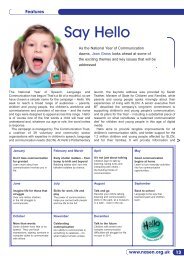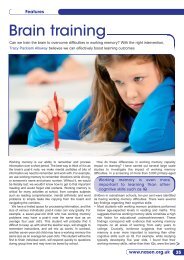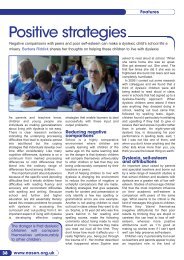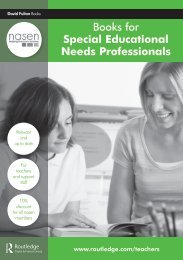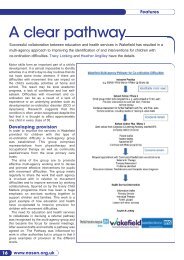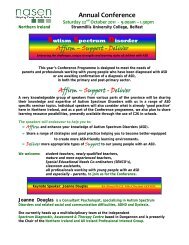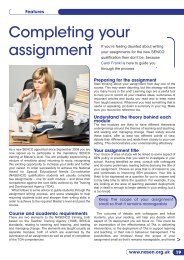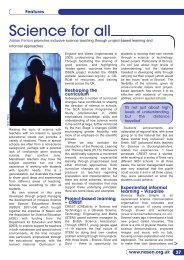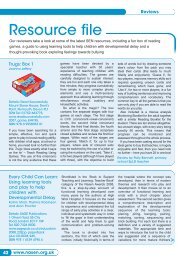<strong>and</strong> how different types of schools, both ma<strong>in</strong>stream <strong>and</strong>special <strong>in</strong> different sectors (primary, secondary <strong>and</strong> tertiary)can work with <strong>and</strong> <strong>support</strong> <strong>gr<strong>and</strong>parents</strong>.Develop<strong>in</strong>g ‘active’ school policiesRecognis<strong>in</strong>g this potential heterogeneity <strong>and</strong> the fact that<strong>in</strong>clud<strong>in</strong>g <strong>gr<strong>and</strong>parents</strong> <strong>in</strong> school life does not ‘just happen’,active school policies <strong>and</strong> <strong>in</strong>itiatives need to be developed<strong>and</strong> implemented. Some key considerations for schools <strong>and</strong>their staff are the need to be sensitive <strong>and</strong> responsive to<strong>family</strong> diversity, <strong>in</strong>clud<strong>in</strong>g: different social, cultural/ethnic<strong>and</strong> class circumstances <strong>and</strong> <strong>family</strong> relationships (especiallywhich families it is appropriate to work with <strong>in</strong> terms of<strong>gr<strong>and</strong>parents</strong> provid<strong>in</strong>g <strong>support</strong>); the impact of differentschool sett<strong>in</strong>gs; <strong>and</strong> also, the need to th<strong>in</strong>k creatively <strong>in</strong>order to <strong>in</strong>clude geographically distanced <strong>gr<strong>and</strong>parents</strong>.Tra<strong>in</strong><strong>in</strong>g <strong>and</strong> developmentFor schools to value ‘<strong>family</strong>-based’ partnerships, schoolstaff must recognise the contribution <strong>gr<strong>and</strong>parents</strong> can maketo both <strong>family</strong> stability <strong>and</strong> school life. Provid<strong>in</strong>g <strong>in</strong>formation<strong>and</strong> tra<strong>in</strong><strong>in</strong>g for school staff is thus important: ideally,a planned <strong>and</strong> coherent programme implemented withgovernment <strong>and</strong>/or local authority <strong>support</strong>. Facilitat<strong>in</strong>gopportunities for schools to share experiences <strong>and</strong> ‘good’practice would also be beneficial. Acknowledg<strong>in</strong>g thecurrent policy <strong>in</strong> Engl<strong>and</strong> of mov<strong>in</strong>g towards ‘extendedschools’, it is also important for schools <strong>and</strong> their staff towork with other relevant agencies, especially social care <strong>and</strong>health services, shar<strong>in</strong>g ideas <strong>and</strong> knowledge as to how bestto provide <strong>support</strong> to <strong>gr<strong>and</strong>parents</strong>.Listen<strong>in</strong>g to <strong>gr<strong>and</strong>parents</strong>In order to facilitate all of the above, it is important forschools <strong>and</strong> their staff to consult with <strong>and</strong> listen to <strong>gr<strong>and</strong>parents</strong>.Current policy guidance highlights the benefits ofwork<strong>in</strong>g <strong>in</strong> partnership with parents (DCSF, 2007; DfES,2006), this approach could usefully be extended to work<strong>in</strong>gwith <strong>gr<strong>and</strong>parents</strong> – how do <strong>gr<strong>and</strong>parents</strong> want to be<strong>in</strong>cluded, especially <strong>gr<strong>and</strong>parents</strong> of children with SEN;<strong>and</strong>, if they do have specific <strong>support</strong> needs, how can schoolsbeg<strong>in</strong> to address these?ReferencesAL-AZAMI, S. (2006) <strong>The</strong> Silver L<strong>in</strong><strong>in</strong>g of My Life: Learn<strong>in</strong>g with Gr<strong>and</strong>parents.A Report of the Work of the National Development Project2005–2006. Nott<strong>in</strong>gham: Basic Skills Agency.ARTHUR, S., SNAPE, D. <strong>and</strong> DENCH, G. (2003) <strong>The</strong> Moral Economy ofGr<strong>and</strong>parent<strong>in</strong>g. London: National Centre for Social Research.BALES, D. (2003) Gr<strong>and</strong>parents Rais<strong>in</strong>g Gr<strong>and</strong>children: Help<strong>in</strong>g YourGr<strong>and</strong>child Deal with the Death of a Parent (Extension publicationCHFD-E 59-4). Athens, GA: <strong>The</strong> University of Georgia CooperativeExtension Service. [Onl<strong>in</strong>e at www.fcs.uga.edu]BARANOWSKI, M. <strong>and</strong> SCHILMOELLER, G. (1999) Gr<strong>and</strong>parents <strong>in</strong>the lives of gr<strong>and</strong>children with disabilities: mothers’ perceptions. Education<strong>and</strong> Treatment of Children, 22, 4, 427–446.BASHFORD, S. (2004) A parent aga<strong>in</strong>. Children Now, 15–21 September,22–23.BERESFORD, B. (Social Policy Research Unit, University of York) (1994)Positively Parents: Car<strong>in</strong>g for a Severely Disabled Child. London:HMSO.BOSTRÖM, A. K. (2002) Increas<strong>in</strong>g social capital <strong>in</strong> the classroom: achallenge for <strong>in</strong>tergenerational learn<strong>in</strong>g. Education <strong>and</strong> Society, 20,3,91–101.BURNS, C. <strong>and</strong> MADIAN, N. (1992) Experiences with a <strong>support</strong> group for<strong>gr<strong>and</strong>parents</strong> of children with disabilities. Paediatric Nurs<strong>in</strong>g, 18, 1,17–21.CARPENTER, B. (1996) Enabl<strong>in</strong>g partnerships: families <strong>and</strong> schools. InB. Carpenter, R. Ashdown <strong>and</strong> K. Bovair (eds.) Enabl<strong>in</strong>g Access:Effective Teach<strong>in</strong>g <strong>and</strong> Learn<strong>in</strong>g for Pupils with Learn<strong>in</strong>g Difficulties.London: David Fulton.CARPENTER, B. (2000) Susta<strong>in</strong><strong>in</strong>g the <strong>family</strong>: meet<strong>in</strong>g the needs offamilies with disabilities. British Journal of Special Education, 27, 3,135–144.CARPENTER, B., ADDENBROOKE, M., ATTFIELD, E. <strong>and</strong> CONWAY,S. (2004) ‘Celebrat<strong>in</strong>g families’: an <strong>in</strong>clusive model of <strong>family</strong>-centredtra<strong>in</strong><strong>in</strong>g. British Journal of Special Education, 31, 2, 75–80.CLARKE, L. <strong>and</strong> CAIRNS, H. (2001) Gr<strong>and</strong>parents <strong>and</strong> the care of children:the research evidence. In B. Broad (ed.) K<strong>in</strong>ship Care: <strong>The</strong>Placement Choice for Children <strong>and</strong> Young People (pp. 11–20). Dorset:Russell House Publish<strong>in</strong>g.CLARKE, L. <strong>and</strong> ROBERTS, C. (2003) Gr<strong>and</strong>parenthood: Its Mean<strong>in</strong>g<strong>and</strong> Its Contribution to Older People’s Lives (Economic <strong>and</strong> SocialResearch Council (ESRC) Research F<strong>in</strong>d<strong>in</strong>gs 22 from the Grow<strong>in</strong>gOlder Programme). Sheffield: ESRC Grow<strong>in</strong>g Older Programme,Department of Sociological Studies, University of Sheffield. [Onl<strong>in</strong>e at:http://www.grow<strong>in</strong>golder.group.shef.ac.uk/GOF<strong>in</strong>d<strong>in</strong>gs22.pdf]CONTACT A FAMILY (2005) Factsheet for Gr<strong>and</strong>parents. London:Contact-a-Family. [Onl<strong>in</strong>e at http://www.ca<strong>family</strong>.org.uk/<strong>gr<strong>and</strong>parents</strong>.html].DANNISON, L. <strong>and</strong> SMITH, A. (2003) Custodial <strong>gr<strong>and</strong>parents</strong> community<strong>support</strong> program: lessons learned. Children <strong>and</strong> Schools, 25,2,87–95.DAYCARE TRUST (2007) Listen<strong>in</strong>g to Parents of Disabled Childrenabout Childcare. London: Daycare Trust.DCSF (DEPARTMENT FOR CHILDREN, SCHOOLS AND FAMILIES)(2007) <strong>The</strong> Children’s Plan: Build<strong>in</strong>g Brighter Futures. London: <strong>The</strong>Stationery Office. [Onl<strong>in</strong>e at http://www.dfes.gov.uk/publications/childrensplan/]DEAN, H. <strong>and</strong> SHAH, A. (2002) Insecure families <strong>and</strong> low-pay<strong>in</strong>g labourmarkets: comments on the British experience. Journal of Social Policy,31, 1, 61–80.DENCH, G. <strong>and</strong> OGG, J. (2002) Gr<strong>and</strong>parent<strong>in</strong>g <strong>in</strong> Brita<strong>in</strong>: A Basel<strong>in</strong>eStudy. London: Institute of Community Studies.DENCH, G., OGG, J. <strong>and</strong> THOMSON, K. (1999) <strong>The</strong> <strong>role</strong> of <strong>gr<strong>and</strong>parents</strong>.In R. Jowell, J. Curtis, A. Park <strong>and</strong> K. Thomson (eds.) British SocialAttitudes: <strong>The</strong> 16 th Report. Hampshire: Ashgate Publish<strong>in</strong>g.DfES (DEPARTMENT FOR EDUCATION AND SKILLS) (2001) SpecialEducational Needs Code of Practice. London: <strong>The</strong> Stationery Office.DfES (DEPARTMENT FOR EDUCATION AND SKILLS) (2004a)Every Child Matters: Change for Children. London: <strong>The</strong> StationeryOffice.DfES (DEPARTMENT FOR EDUCATION AND SKILLS) (2004b) EveryChild Matters: Change for Children <strong>in</strong> Schools. London: <strong>The</strong> StationeryOffice.DfES (DEPARTMENT FOR EDUCATION AND SKILLS) (2006) ChildcareAct 2006: Chapter 21. Norwich: <strong>The</strong> Stationery Office. [Onl<strong>in</strong>e athttp://www.opsi.gov.uk/acts/acts2006/pdf/ukpga_20060021_en.pdf].DfES (DEPARTMENT FOR EDUCATION AND SKILLS) (2007a) EveryParent Matters: Help<strong>in</strong>g You Help Your Child. London: <strong>The</strong> StationeryOffice.© 2008 <strong>The</strong> Author(s). Journal compilation © 2008 NASEN Support for Learn<strong>in</strong>g · Volume 23 · Number 3 · 2008 133
DfES (DEPARTMENT FOR EDUCATION AND SKILLS) (2007b)Special Educational Needs <strong>in</strong> Engl<strong>and</strong>, January 2007. London: DfES.[Onl<strong>in</strong>e at http://www.dfes.gov.uk/rsgateway/DB/SFR/s000732/sfr20-2007.pdf]DE TOLEDO, S. <strong>and</strong> ELDER BROWN, D. (1995) Gr<strong>and</strong>parents asParents: A Survival Guide for Rais<strong>in</strong>g a Second Family. New York,NY: <strong>The</strong> Guilford Press. Adapted for the ‘Gr<strong>and</strong>parents Rais<strong>in</strong>g Gr<strong>and</strong>kids’program, Texas A&M University. [Onl<strong>in</strong>e at http://fcs.tamu.edu/families/ag<strong>in</strong>g/grg/]DILWORTH-ANDERSON, P. (1994) <strong>The</strong> importance of <strong>gr<strong>and</strong>parents</strong> <strong>in</strong>extended-k<strong>in</strong> caregiv<strong>in</strong>g to black children with sickle cell disease.Journal of Health Social Policy, 5, 3/4, 185–202.DISABILITY DISCRIMINATION ACT (1995) Chapter 50. London: HerMajesty’s Stationery Office. [Onl<strong>in</strong>e at http://www.opsi.gov.uk/ACTS/acts1995/ukpga_19950050_en_1]DTI (DEPARTMENT OF TRADE AND INDUSTRY) (2000) Work <strong>and</strong>Parents: Competitiveness <strong>and</strong> Choice – A Research Review. London:<strong>The</strong> Stationery Office.DUNST, C. J., TRIVETTE, C. M. <strong>and</strong> DEAL, A. G. (1994) Support<strong>in</strong>g <strong>and</strong>Strengthen<strong>in</strong>g Families (Vol. 1): Methods, Strategies <strong>and</strong> Practices.Cambridge, MA: Brookl<strong>in</strong>e Books.EDWARDS, O. W. <strong>and</strong> SWEENEY, A. E. (2007) <strong>The</strong>ory-based <strong>in</strong>terventionsfor school children cared for <strong>by</strong> their <strong>gr<strong>and</strong>parents</strong>. EducationalPsychology <strong>in</strong> Practice, 23, 2, 177–190.EVASON, E., LLOYD, K. <strong>and</strong> DOWDS, L. (2005) Gr<strong>and</strong>parenthood <strong>in</strong>Modern Irel<strong>and</strong>. Dubl<strong>in</strong>: Department of Social <strong>and</strong> Family Affairs(Republic of Irel<strong>and</strong>). [Onl<strong>in</strong>e at: http://www.welfare.ie/publications/granparent.pdf]EVERY DISABLED CHILD MATTERS (2007) Disabled children <strong>and</strong>child poverty (brief<strong>in</strong>g paper). London: Every Disabled Child Matters.FAMILY FUND TRUST (2003) Statistical Analysis. York: Family Fund.FERGUSON, N. (2004) Gr<strong>and</strong>parent<strong>in</strong>g <strong>in</strong> Divorced Families. Bristol:Policy Press.FINDLER, L. (2000) <strong>The</strong> <strong>role</strong> of <strong>gr<strong>and</strong>parents</strong> <strong>in</strong> the social <strong>support</strong> systemof mothers of children with a physical disability. Families <strong>in</strong> Society:Journal of Contemporary Human Services, 81, 4, 370–381.FINDLER, L. (2007) Gr<strong>and</strong>parents – the overlooked potential partners:perceptions <strong>and</strong> practice of teachers <strong>in</strong> special <strong>and</strong> regular education.European Journal of Special Needs Education, 22, 2, 199–216.FINDLER, L. <strong>and</strong> BEN-ARI, O. (2003) Social workers’ perceptions <strong>and</strong>practice regard<strong>in</strong>g <strong>gr<strong>and</strong>parents</strong> <strong>in</strong> families of children with a developmentaldisability. Families <strong>in</strong> Society, 84, 1, 86–99.FUTURE FOUNDATION (2002) Complicated Lives III: a report <strong>by</strong>the Future Foundation for Abbey National. London: FutureFoundation.GARDNER, J., SCHERMAN, A., MOBLEY, D., BROWN, P. <strong>and</strong>SCHUTTER, M. (1994) Gr<strong>and</strong>parents’ beliefs regard<strong>in</strong>g their <strong>role</strong> <strong>and</strong>relationship with special needs gr<strong>and</strong>children. Education <strong>and</strong> Treatmentof Children, 17, 2, 185–196.GEORGE, J. (1988) <strong>The</strong>rapeutic <strong>in</strong>tervention for <strong>gr<strong>and</strong>parents</strong> <strong>and</strong>extended families of children with developmental delays. Mental Retardation,26, 369–375.GRANDPARENTS PLUS (2003) Gr<strong>and</strong>parents Talk<strong>in</strong>g: Report ofSem<strong>in</strong>ar Held at the Nuffield Foundation, London (5 June). London:Gr<strong>and</strong>parents Plus.GRANT, R., GORDON, S. G. <strong>and</strong> COHEN, S. T. (1997) An <strong>in</strong>novativeschool-based <strong>in</strong>tergenerational model to serve gr<strong>and</strong>parent caregivers.Journal of Gerontological Social Work, 28, 1/2, 47–61.GRAY, A. (2005a) <strong>The</strong> chang<strong>in</strong>g availability of <strong>gr<strong>and</strong>parents</strong> as carers <strong>and</strong>its implications for childcare policy <strong>in</strong> the UK. Journal of Social Policy,34, 4, 557–577.GRAY, A. with GRANDPARENTS ASSOCIATION (2005b) An Evaluationof the Gr<strong>and</strong>parent–Toddler Groups Initiative. London: Families<strong>and</strong> Social Capital Group, South Bank University.GREEN, S. (2001) Gr<strong>and</strong>ma’s h<strong>and</strong>s: parental perceptions of the importanceof <strong>gr<strong>and</strong>parents</strong> as secondary caregivers <strong>in</strong> families of childrenwith disabilities. International Journal of Age<strong>in</strong>g <strong>and</strong> Human Development,53, 1, 11–33.GREGORY, E., ARJU, T., JESSEL, J., KENNER, C. <strong>and</strong> RUBY, M.(2007) Snow white <strong>in</strong> different guises: <strong>in</strong>terl<strong>in</strong>gual <strong>and</strong> <strong>in</strong>terculturalexchanges between <strong>gr<strong>and</strong>parents</strong> <strong>and</strong> young children at home <strong>in</strong> EastLondon. Journal of Early Childhood Literacy, 7, 1, 5–25.GRUNDY, E. (1999) Look<strong>in</strong>g beyond the household: <strong>in</strong>tergenerationalperspectives on liv<strong>in</strong>g k<strong>in</strong> <strong>and</strong> contacts with k<strong>in</strong> <strong>in</strong> Great Brita<strong>in</strong>. PopulationTrends, 97, 19–27.GYLLENSPETZ, I. (2007) Learn<strong>in</strong>g with Gr<strong>and</strong>parents: Triall<strong>in</strong>g theMaterials. Leicester: Basic Skills Agency @ NIACE.HARRIS, S., HANDLEMAN, J. <strong>and</strong> PALMER, C. (1985) Parents <strong>and</strong><strong>gr<strong>and</strong>parents</strong> view the autistic child. Journal of Autism <strong>and</strong> DevelopmentalDisorders, 15, 2, 127–137.HASTINGS, R. (1997) Gr<strong>and</strong>parents of children with disabilities: a review.International Journal of Disability, Development <strong>and</strong> Education, 44, 4,329–340.HASTINGS, R., THOMAS, H. <strong>and</strong> DELWICHE, N. (2002) Gr<strong>and</strong>parents’<strong>support</strong> for children with Down’s Syndrome. Journal of AppliedResearch <strong>in</strong> Intellectual Disabilities, 15, 1, 97–104.HATTON, C., AKRAM, Y., SHAH, R., ROBERTSON, J. <strong>and</strong> EMERSON,E. (2004) Support<strong>in</strong>g South Asian Families with a Child with SevereDisabilities. London: Jessica K<strong>in</strong>gsley.HM TREASURY, DEPARTMENT FOR EDUCATION AND SKILLS(DfES), DEPARTMENT FOR WORK AND PENSIONS (DWP),DEPARTMENT OF TRADE AND INDUSTRY (DTI) (2004) Choicefor Parents, the Best Start for Children: A Ten Year Strategy for Childcare.London: <strong>The</strong> Stationery Office.HORNBY, G. <strong>and</strong> ASHWORTH, T. (1994) Gr<strong>and</strong>parents’ <strong>support</strong> forfamilies who have children with disabilities. Journal of Child FamilyStudies, 3, 403–412.HORTON, T. V. <strong>and</strong> WALLENDER, J. L. (2001) Hope <strong>and</strong> social <strong>support</strong>as resilience factors aga<strong>in</strong>st psychological distress of mothers who carefor children with chronic physical conditions. Rehabilitation Psychology,46, 382–399.JESSEL, J., GREGORY, E., ARJU, T., KENNER, C. <strong>and</strong> RUBY, M.(2004) Children <strong>and</strong> their <strong>gr<strong>and</strong>parents</strong> at home: a mutually <strong>support</strong>ivecontext for learn<strong>in</strong>g <strong>and</strong> l<strong>in</strong>guistic development. English Quarterly,36,4, 16–23.KAGAN, C., LEWIS, S. <strong>and</strong> HEATON, P. (1998) Comb<strong>in</strong><strong>in</strong>g Work <strong>and</strong>Care: Work<strong>in</strong>g Parents of Disabled Children (F<strong>in</strong>d<strong>in</strong>gs: Ref. 538).York: Joseph Rowntree Foundation.KENNER, C., ARJU, T., GREGORY, E., JESSEL, J. <strong>and</strong> RUBY, M.(2004) <strong>The</strong> <strong>role</strong> of <strong>gr<strong>and</strong>parents</strong> <strong>in</strong> children’s learn<strong>in</strong>g. Primary Practice,38, 41–44.KENNER, C., RUBY, M., JESSEL, J., GREGORY, E. <strong>and</strong> ARJU, T.(2007) Intergenerational learn<strong>in</strong>g between children <strong>and</strong> <strong>gr<strong>and</strong>parents</strong> <strong>in</strong>East London. Journal of Early Childhood Research, 5,3,219–243.KNUSSEN, C. <strong>and</strong> SLOPER, P. (1992) Stress <strong>in</strong> families of children witha disability: a review of risk <strong>and</strong> resistance factors. Journal of MentalHealth, 1, 241–256.KROPF, N. <strong>and</strong> BURNETTE, D. (2003) Gr<strong>and</strong>parents as <strong>family</strong> caregivers:lessons for <strong>in</strong>tergenerational education. EducationalGerontology, 29, 4, 361–372.LAVERS, C. <strong>and</strong> SONUGA-BARKER, E. J. S. (1997) Annotation: on thegr<strong>and</strong>mothers’ <strong>role</strong> <strong>in</strong> the adjustment <strong>and</strong> maladjustment of gr<strong>and</strong>children.Journal of Child Psychology <strong>and</strong> Psychiatry, 38, 7, 747–753.LAWRENCE-WEBB, C., OKUNDAYE, J. <strong>and</strong> HAFNER, G. (2003) Education<strong>and</strong> k<strong>in</strong>ship caregivers: creat<strong>in</strong>g a new vision. Families <strong>in</strong>Society: Journal of Contemporary Human Services, 84, 1, 135–142.LUSSIER, G., DEATER-DECKARD, K., DUNN, J. <strong>and</strong> DAVIES, L.(2002) Support across two generations. Journal of Family Psychology,16, 363–376.McGLONE, F., PARK, A. <strong>and</strong> ROBERTS, C. (1999) K<strong>in</strong>ship <strong>and</strong> friendships:attitudes <strong>and</strong> behaviour <strong>in</strong> Brita<strong>in</strong> 1986–1995. In S. McRae (ed.)Chang<strong>in</strong>g Brita<strong>in</strong>: Families <strong>and</strong> Households <strong>in</strong> the 1990s (pp. 141–155). Oxford: Oxford University Press.MIRFIN-VEITCH, B. <strong>and</strong> BRAY, A. (1997) Gr<strong>and</strong>parents: part of the<strong>family</strong>. In B. Carpenter (ed.) Families <strong>in</strong> Context: Emerg<strong>in</strong>g Trends <strong>in</strong>Family Support <strong>and</strong> Early Intervention (pp. 76–88). London: DavidFulton.MIRFIN-VEITCH, B., BRAY, A. <strong>and</strong> WATSON, M. (1996) ‘<strong>The</strong>y really docare’: <strong>gr<strong>and</strong>parents</strong> as <strong>in</strong>formal <strong>support</strong> sources for families of childrenwith disabilities. New Zeal<strong>and</strong> Journal of Disabilities, 2, 136–148.134 Support for Learn<strong>in</strong>g · Volume 23 · Number 3 · 2008 © 2008 <strong>The</strong> Author(s). Journal compilation © 2008 NASEN



